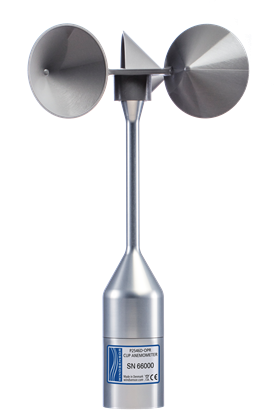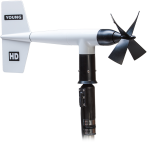
Ideal for wind-energy applications






Aperçu
The P2546D, manufactured by WINDSENSOR, is a Class 1 cup anemometer commonly used in wind resource assessment and power performance applications. Each anemometer is individually calibrated compliant with IEC 61400-12-1 and is shipped with a MEASNET calibration certificate. The P2546D features permanent magnets mounted on the shaft that activate an electronic switching current. In response, this generates an output signal with a frequency that is proportional to the wind speed. The durable construction is suitable for both on-shore and off-shore environments. The “D” version of this sensor (electronic version) is compatible with all Campbell Scientific measurement and control data loggers.
Other available versions:
Avantages et caractéristiques
- One-piece rotor anemometer head (OPR)
- Durable construction with anodized aluminum and stainless steel
- Low threshold speed
- Short distance constant
- Negligible overspeeding
- Angular response independent of wind speed
- Fully tested temperature performance
- Symmetrical geometry
- No external power source
- MEASNET calibrated
Images

Compatibilité
Spécifications
| Sensor | 3-cup anemometer |
| Measurement Description | Wind speed |
| Range | 0 to 75 m/s |
| Starting Threshold | < 0.3 m/s |
| Starting Speed | 0.27 m/s |
| Gain | 0.6201 m |
| Distance Constant | λ0 = 1.81 ± 0.04 m |
| Standard Deviation of Offset | 0.014 m/s |
| Standard Deviation of Gain | 0.027 m |
| Variation among Units | ±1% |
| Non-Linearity | < 0.04 m/s |
| Temperature Influence | < 0.05 m/s (-15° to +60°C) |
| -NOTE- | The specifications are based on 80 wind tunnel calibrations performed according to the Measnet Cup Anemometer Calibration Procedure. The specified offset and gain figures represent the mean values of these calibrations. Variation among units designates the maximum deviation of any unit from the straight line representing these mean values. All units are run-in for 225 hours at 9 ms-1, in order to reduce the initial bearing friction to a level close to the steady state value. After run-in, bearing friction is tested at -15°C and at room temperature. The allowed limits for this test assure that the temperature influence on the calibration is within the specified limit. |
Calibration |
|
| Standard | U=A0+B0×f |
| Wind Speed | U [m/s] |
| Offset | A0=0.27 m/s ("starting speed") |
| Gain | B0=0.620 m |
| Output Frequency | f [Hz] |
Switching Characteristics |
|
| Signal Type | Potential free contact closure |
| Duty Cycle | 45% to 55% |
| Maximum Switching Voltage | 30 V |
| Maximum Recommended Switching Current | 10 mA |
| Series Resistance | 60 Ω |
| Operating Temperature Range | -40° to +60°C |
FAQ
Nombre de FAQ au sujet de(s) P2546D-L: 1
-
De nombreux capteurs Campbell Scientific sont disponibles avec différentes options de terminaison de câble. Ces options comprennent les éléments suivants :
- Par défaut le câble du capteur se termine par des fils étamés, qui se connectent directement au bornier d'un multiplexeur ou d'une centrale de mesure.
- Vous pouvez choisir d'avoir un connecteur qui se fixera sur une embase sur votre coffret pré-câblé, dans ce cas il faut prendre l'option 03C (référence : 009384) ou 02C (on utilisera un connecteur 02C (référence : 009551) pour un panneau solaire par exemple).
- Certains systèmes de mesure comme le CS110, les stations météorologiques ET107 ou l'ET106 ont des connecteurs spéciaux.
- Pour les capteurs sans fil de la série CWS (il existe des connecteurs pour le module CWS900E en option), cela permet de connecter un capteur à l'interface sans fil CWS900E.
Note : La disponibilité des options de terminaison du câble varie selon le capteur. Par exemple, les capteurs peuvent avoir aucune, deux ou plusieurs options à choisir. Si une option souhaitée n'est pas répertoriée pour un capteur spécifique, contactez Campbell Scientific pour obtenir de l'aide.





